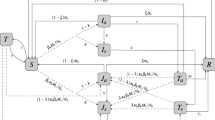Abstract
In this paper, we introduce a deterministic malaria model for determining the drug administration protocol that leads to the smallest first malaria episodes during the wet season. To explore the effects of administering the malaria drug on different days during the wet season while minimizing the potential harmful effects of drug overdose, we define 40 drug administration protocols. Our results fit well with the clinical studies of Coulibaly et al. at a site in Mali. In addition, we provide protocols that lead to smaller number of first malaria episodes during the wet season than the protocol of Coulibaly et al.
Similar content being viewed by others
References
Bailey, N.T.J., 1957. The Mathematical Theory of Epidemics, 1st edn. Griffin, London.
Bekessey, A., Molineaux, L., Storey, J., 1976. Estimation of incidence and recovery rates of Plasmodium falciparum parasitaemia from longitudinal data. Bull. World Health Organ. 54, 685–693.
Carnevale, P., Mouchet, J., Coosemans, M., Julvez, J., Manguin, S., Lenoble, R.D., Sircoulou, S., 2004. Biodiversité du paludisme dans le monde. Editions John Libbey Eurotext, Paris.
Coulibaly, D., Diallo, D., Thera, M., Dicko, A., Guindo, A., Kone, A., Cissoko, Y., Coulibaly, S., Djimde, A., Lyke, K., Doumbo, O., Plowe, C., 2002. Impact of preseason treatment on incidence of falciparum malaria and parasite density at a site for testing malaria vaccines in Bandiagara, Mali. Am. J. Trop. Med. Hyg. 67(6), 604–610.
Dembele, B., Friedman, A., Yakubu, A.-A., 2009. Malaria model with periodic mosquito birth and death rates. J. Biol. Dyn. 3(4), 430–445.
Dietz, K., 1970. Mathematical models for malaria in different ecological, zones. Presented to the 7th International Biometric Conference, Hannover, August 1970, 16–21.
Dietz, K., 1988. Mathematical models for transmission and control of malaria. In: Wernsdorfer, W.H., McGregor, I. (Eds.), Principles and Practice of Malariology, pp. 1091–1113. Churchill Livingstone, London.
Gideon, A.N., Shu, W.S., 1999. A Mathematical Model for Endemic Malaria with Variable Human and Mosquito populations. United Nations Educational Scientific and Cultural Organization and International Atomic Energy Agency (http://www.ictp.trieste.it/~pub_off) IC, pp. 1–27.
Grassly, N.C., Fraser, C., 2006. Seasonal infectious disease epidemiology. Proc. R. Soc. B 273, 2541–2550.
Kermack, W.O., McKendrick, A.G., 1927. Contributions to the mathematical theory of epidemics (part I). Proc. R. Soc. A 115, 700–721.
Lokta, A.J., 1923. Contributions to the analysis of malaria epidemiology. Am. J. Hyg. 3, 1–121.
Macdonald, G., 1950. The analysis of infection rates in diseases in which supperinfection occurs. Trop. Dis. Bull. 47, 907–915.
Martini, E., 1921. Berechnungen und Beobachtungen zur Epidemiologie und Bekam̈pfung der Malaria. Gente, Hamburg.
McKenzie, F.E., Bossert, H.W., 2005. An integrated model of Plasmodium falciparum dynamics. J. Theor. Biol. 232, 411–426.
National Institute of Allergy and Infectious Diseases, 2002. Publication No. 02-7139, Malaria.
Norman, T.J., Baley, M.A., 1982. The Biomathematics of Malaria. Oxford University Press, London.
Ross, R., 1911. The Prevention of Malaria, 2nd edn. Murray, London. With Addendum on the Theory of Happenings.
Sagoba, N., Doumbia, S., Vounatsou, P., Baber, I., Keita, M., Maiga, M., Tourė, S., Dolo, G., Smith, T., Ribeiro, J.M.C., 2007. Monitoring of larval habitats and mosquito densities in the Sudan savanna of Mali: implications of malaria vector control. Am. J. Trop. Med. Hyg. 77, 82–88.
Author information
Authors and Affiliations
Corresponding author
Rights and permissions
About this article
Cite this article
Dembele, B., Friedman, A. & Yakubu, AA. Mathematical Model for Optimal Use of Sulfadoxine-Pyrimethamine as a Temporary Malaria Vaccine. Bull. Math. Biol. 72, 914–930 (2010). https://doi.org/10.1007/s11538-009-9476-9
Received:
Accepted:
Published:
Issue Date:
DOI: https://doi.org/10.1007/s11538-009-9476-9




